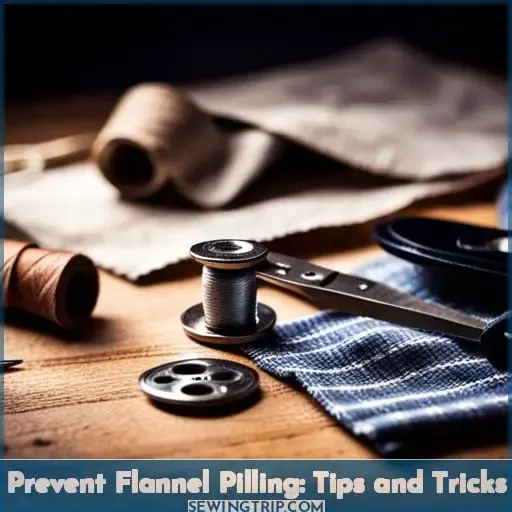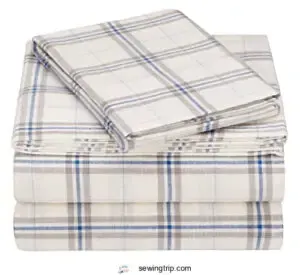This site is supported by our readers. We may earn a commission, at no cost to you, if you purchase through links.
 Indulge in the luxurious comfort of flannel sheets without worrying about those pesky pills. Discover expert tips and tricks to keep your flannel smooth and pill-free, allowing you to enjoy a cozy night’s sleep every time.
Indulge in the luxurious comfort of flannel sheets without worrying about those pesky pills. Discover expert tips and tricks to keep your flannel smooth and pill-free, allowing you to enjoy a cozy night’s sleep every time.
From choosing high-quality fabrics to implementing proper care techniques, you’ll learn how to prevent pilling and maintain the pristine condition of your beloved flannel sheets.
Say goodbye to lumps and hello to ultimate relaxation with our essential guide on preventing flannel pilling.
Table Of Contents
- Key Takeaways
- What is Pilling and How Does It Affect Flannel?
- How to Prevent and Fix Pilling on Flannel Sheets
- Choosing the Best Flannel Sheets to Avoid Pilling
- Proper Washing and Drying Techniques for Flannel Sheets
- How to Remove Fuzz and Pills From Flannel Sheets
- Understanding the Effects of Drying Flannel Sheets
- Addressing Wrinkles in Flannel Sheets
- When to Consider Buying New Flannel Sheets
- Tips for a Perfect Night’s Sleep With Flannel Sheets
- Frequently Asked Questions (FAQs)
- Conclusion
Key Takeaways
- Choose high-quality flannel sheets made from natural fibers to minimize pilling.
- Wash flannel sheets inside out and with like colors to reduce friction and prevent pilling.
- Use a gentle cycle and cold water when washing flannel sheets to minimize wear and tear.
- Avoid using fabric softeners and dryer sheets, as they can contribute to pilling.
What is Pilling and How Does It Affect Flannel?
Flannel is a popular fabric choice known for its softness and warmth. However, like other materials such as cotton, bamboo, and microfiber, flannel is susceptible to pilling.
Pilling occurs when small balls of fiber form on the surface of the fabric due to friction from wear and tear. This can affect the overall appearance and feel of flannel sheets or clothing, making it important to understand how to prevent pilling for long-lasting enjoyment of your favorite flannel pieces.
Common Materials Affected
Pilling is a common issue that affects various materials, including flannel sheets.
Cotton, bamboo, wool, polyester, and nylon can all experience pilling on flannel fabric.
Cotton

When you use flannel sheets made from cotton, pilling can occur due to the friction and wear of the fabric. Cotton is a popular choice for flannel because it’s soft, breathable, and durable. However, over time and with repeated use, tiny balls of thread can form on the surface of your cotton flannel sheets.
These pills not only affect the appearance of your sheets but also make them feel rougher to touch.
To prevent pilling on cotton flannel sheets:
- Soft and comfortable against skin
- Breathable fabric that helps regulate body temperature
- Durable and long-lasting
- Prone to pilling with frequent use
- Requires proper care to maintain its quality
- May shrink if washed in hot water or dried at high heat
Bamboo
To prevent pilling on bamboo flannel sheets, wash them carefully and avoid fabric softener.
Bamboo fabric is prone to pilling, so handle with care during washing and drying.
Microfiber
As we continue our discussion on preventing flannel pilling, let’s now delve into the impact of microfiber on flannel sheets.
Microfiber can contribute to pilling due to its soft and fine fibers. To prevent pilling, choose high-quality microfiber sheets and follow proper care instructions.
Flannel
Flannel sheets are prone to pilling, which is the formation of tiny balls of thread on the fabric, affecting their overall appearance and comfort.
To avoid pilling:
- Avoid using fabric softener and dryer sheets on flannel.
- Use a gentle cycle in the washing machine.
- Dry flannel sheets at a low temperature in the dryer.
- Avoid ironing flannel as it can contribute to pilling.
Low-Quality Fabric
Low-quality fabric can significantly contribute to pilling on flannel sheets. Choose high-thread count, quality sheets made from cotton, bamboo, or microfiber for breathable and durable options.
| Material | Pilling |
|---|---|
| Cotton | Prone to pilling due to its natural fiber structure. |
| Bamboo | Less likely to pill compared to cotton due to its smooth fibers. |
| Microfiber | Resistant against pilling because of tightly woven synthetic fibers. |
High thread count fabrics are generally more resistant against pilling as they’ve a denser weave that prevents excess friction between the threads. When selecting flannel sheets, opt for those with a higher thread count for increased durability and reduced chances of pilling over time.
It is essential to invest in quality bedding materials like snuggle flannel that offer both comfort and longevity without sacrificing style or function.
How to Prevent and Fix Pilling on Flannel Sheets
To prevent and fix pilling on your flannel sheets, there are a few techniques you can try.
First, use a razor or lint roller to gently remove the pills from the surface of the fabric.
Alternatively, you can carefully cut off the pills with scissors.
Lastly, consider investing in a battery-operated fuzz remover for more efficient pill removal.
How to Fix Pilling
To fix pilling on flannel sheets, start by:
- Using a razor and lint roller to gently remove the pills.
- Considering using a fabric shaver for more stubborn pills.
- Remembering to wash your sheets in cool water to prevent further pilling.
Use a Razor and Lint Roller
To prevent and fix pilling on your flannel sheets, use a razor at a slight angle to gently remove the pills.
- Apply light pressure and move in one direction.
- Then, use a lint roller with adhesive type to pick up any remaining fibers.
Cut Off the Pills With Scissors
To prevent and fix pilling on flannel sheets, you can easily cut off the pills with a pair of scissors.
- Gently hold the fabric taut.
- This will help to prevent you from cutting into the fabric itself.
- Locate the pills and carefully snip them off close to the surface.
- Be sure to only snip off the pills and not the fabric itself.
- Make sure not to cut into the fabric itself.
- This will help to prevent the pills from coming back.
- Dispose of or collect any loose pill remnants for disposal.
- This will help to keep your sheets looking their best.
Use a Battery-Operated Fuzz Remover
Use a battery-operated fuzz remover to easily remove pills from your flannel sheets.
Gently glide the fuzz remover over the fabric, allowing the rotating blades to catch and cut away the pilling.
Clean regularly for optimal performance and prevention of future pilling.
Choosing the Best Flannel Sheets to Avoid Pilling
When it comes to choosing the best flannel sheets to avoid pilling, there are a few key factors to consider:
- Opt for high-quality flannel sheets made from long-staple cotton fibers, as they tend to be more durable and resistant to pilling.
- Look for sheets with a higher thread count and double-napped finish, which helps prevent friction-induced pilling.
- Avoid blends that contain wool or synthetic fibers as these materials can contribute to increased pilling over time.
Best Sheets to Avoid Pilling
Choose high-quality flannel sheets with a higher thread count.
Avoid cotton blends or bamboo sheets to prevent pilling.
Wash them properly using the right temperature and dryer setting.
Egyptian Cotton Sheets
When looking to avoid pilling on your flannel sheets, consider investing in high-quality Egyptian cotton sheets.
They’re soft, breathable, warm and durable.
Pima Cotton Sheets
To avoid pilling on your flannel sheets, prioritize the selection of high-quality Pima cotton sheets.
These soft, durable, and breathable sheets are cooling and can be air-dried with a gentle detergent to prevent pilling and shrinkage.
Percale Sheets
By selecting high-quality percale sheets, you can effectively prevent pilling on your flannel bedding.
Percale sheets are soft, breathable, durable, and affordable options that help prevent pilling.
Linen Sheets
Now let’s talk about linen sheets and how they can help you avoid pilling on your flannel sheets.
Linen offers:
- High thread count
- Durability
- Softness
- Temperature regulation
- Wrinkle resistance
Bamboo Sheets
When it comes to preventing pilling on flannel sheets, choose bamboo sheets.
They’re soft, breathable, durable, and hypoallergenic.
Proper Washing and Drying Techniques for Flannel Sheets
To properly care for your flannel sheets and prevent pilling, it’s essential to follow the right washing and drying techniques.
Begin by giving your new sheets an initial wash before use to remove any excess fibers.
When machine-washing, opt for a gentle cycle with cool or warm water instead of hot water, as heat can damage the fabric.
Avoid using fabric softeners and additives that may contribute to pilling over time.
Additionally, spot clean any stains with care rather than subjecting the entire sheet to aggressive washing cycles.
The Initial Wash
To properly wash and dry your flannel sheets, start with a gentle detergent.
Wash in warm water, skip fabric softener, use vinegar in the final rinse, and dry on low heat with dryer balls.
Machine Cycle
To properly care for your flannel sheets and prevent pilling, follow these steps for the machine cycle:
Step 1:
- Use warm water.
- Be gentle during washing.
Step 2:
- Dry on low heat.
- Air dry if possible.
Remember to add a half cup of white vinegar to the final rinse to further protect your flannel sheets.
Water Temperature
How can you ensure the proper washing and drying techniques for flannel sheets to prevent pilling? Here are four tips:
- Use warm water, not hot or cold.
- Avoid extreme temperatures like lukewarm or room temperature.
- Don’t use fabric softener during washing.
- Dry flannel sheets on low heat in the dryer.
[ADDITIONAL INFORMATION]:
Flannelsheets.org recommends using a gentle cycle when washing your flannel sheets and avoiding harsh detergents that may cause damage to the fabric fibers.
The warmth of warm water is ideal for cleaning without causing excessive friction that can lead to pilling.
Hot water should be avoided as it can shrink and distort the shape of your flannel sheets over time.
Coldwater is also not recommended as it may not effectively remove dirt and stains from your bedding while still being gentle enough on delicate fabrics like wool blends used in some high-quality flannelsheets.
Softeners and Additives
You can keep your flannel sheets comfy by avoiding fabric softeners and additives.
Instead, try using vinegar or wool dryer balls for a natural alternative.
Preventing Pilling Over Time
When it comes to preventing pilling over time, preserve your flannel sheets by:
- Washing in cool water
- Avoiding fabric softener
- Air drying them
Spot Clean With Care
To prevent pilling on your flannel sheets,
- Wash them in cold water with gentle detergent.
- Hang dry.
- Use a fabric shaver to remove pills.
- Avoid fabric softener.
How to Remove Fuzz and Pills From Flannel Sheets
To keep your flannel sheets looking fresh and smooth, it’s important to know how to remove fuzz and pills that may have already formed.
You can easily remove fuzz by gently brushing the fabric with a lint roller or a soft-bristled brush.
For more stubborn pills, use a fabric shaver or sweater stone in circular motions to safely lift them away without damaging the flannel.
How to Remove Fuzz
To remove fuzz and pills from flannel sheets, gently glide a fabric shaver or lint roller over the surface.
Another method is to use a depiller, specifically designed to remove pilling from fabrics.
If you don’t have these tools on hand, try using alternative methods such as:
- Rubbing a tennis ball over the surface
- Using steam from a steamer or hair dryer to loosen and release trapped fuzz.
- For more stubborn pills, lightly rub them with a pumice stone in circular motions until they’re no longer visible.
How to Remove Pills That Have Already Formed
To remove pills that have already formed on your flannel sheets, you can use a razor and lint roller to gently lift them off.
Start by running the razor over the surface of the fabric in short strokes, being careful not to press too hard.
Then, use a lint roller to pick up any loose pills that remain.
This method works well for removing pills from wool flannel as well as other types of fabric prone to pilling like sweaters or flannel shirts.
Understanding the Effects of Drying Flannel Sheets
When it comes to drying flannel sheets, it’s important to understand the potential effects.
While flannel can be dried in a dryer, excessive heat may cause shrinking and damage to the fabric.
It’s recommended to air-dry your flannel sheets whenever possible or use low heat settings in the dryer for shorter periods of time to prevent these undesirable effects.
Can You Put Flannel Sheets in the Dryer?
You can put flannel sheets in the dryer, but it’s important to understand the effects of drying them.
Set your dryer on low heat to avoid damaging the fabric.
Use a dryer sheet to reduce static and add a pleasant scent.
Clean out the lint trap regularly to prevent lint buildup and maintain optimal drying performance.
But, if You Really Need to Dry Your Flannel Sheets
If you find yourself needing to dry your flannel sheets, it’s important to understand the effects that drying can have on them.
- Use a dryer sheet to reduce static and provide a fresh scent.
- Tumble dry on low heat or air dry for gentle drying.
- Avoid using high heat settings or skipping the dryer altogether for optimal results.
When it comes time to dry your precious flannel sheets, there are several factors you need to take into consideration in order to preserve their softness and prevent damage caused by excessive heat or agitation.
Firstly, if you choose to use a dryer when drying your flannel sheets (which isn’t recommended), be sure to use the lowest heat setting possible. Flannel sheets are made from a delicate fabric that can easily be damaged by high heat, so it’s important to protect them by using the lowest setting possible.
Secondly, be sure to tumble dry your flannel sheets on a gentle cycle. This will help to prevent them from becoming tangled or damaged.
Finally, avoid using fabric softener when drying your flannel sheets. Fabric softener can coat the fibers of the fabric and make them feel stiff and uncomfortable.
By following these tips, you can help to ensure that your flannel sheets stay soft and comfortable for years to come.
Does Flannel Shrink in the Dryer?
When drying your flannel sheets, it’s important to understand the effects of heat and moisture on their fabric.
To prevent shrinking, avoid high heat in the dryer and opt for low or air-drying instead.
Hanging your flannel sheets to dry is also a great option that will help maintain their size and shape.
| Method | Heat Level |
|---|---|
| Dryer | Low Heat |
| Dryer | High Heat |
| Air-Dry | N/A |
Addressing Wrinkles in Flannel Sheets
Smooth out wrinkles in your flannel sheets for a neat and tidy bed.
Flannel is known for its warmth and coziness, but it can also be prone to wrinkling. To keep your flannel sheets looking wrinkle-free, it’s important to follow proper care instructions.
After washing, avoid using the dryer as high heat can cause more wrinkles to form. Instead, opt for air-drying by laying the sheets flat or hanging them up to dry.
If you prefer a smoother look, you can use a steam iron on low heat while the fabric is still slightly damp.
Remember that not all flannels are wrinkle-resistant, so taking these steps will help maintain their appearance and prolong their lifespan.
When to Consider Buying New Flannel Sheets
As a fashion-forward individual who values comfort and style, you may find yourself wondering when it’s time to invest in new flannel sheets.
One key indicator is the appearance of excessive pilling, those pesky little balls of thread that can mar the smooth surface of your beloved sheets.
Another factor to consider is the overall condition and durability of your current flannel sheets – if they’ve become thin or worn out over time, it may be a sign that it’s time for an upgrade.
When shopping for new flannel sheets, look for high-quality materials and construction that will withstand regular use without sacrificing softness or warmth.
When Should I Look for New Sheets?
You should start considering buying new flannel sheets when they’ve become worn out or after a significant amount of time has passed.
- Visible wear and tear, such as thinning fabric or holes
- Excessive pilling that can’t be fixed
- Decreased comfort due to loss of softness and warmth.
What Should I Look for When Buying New Sheets?
If you notice excessive pilling on your flannel sheets, it may be time to consider purchasing a new set.
When buying new sheets, there are a few important factors to keep in mind:
- Look for a higher thread count for better durability and softness.
- Consider opting for 100% cotton or a cotton blend with other natural fibers.
- Pay attention to the recommended washing temperature and dryer setting on the care label.
- Avoid using fabric softener as it can contribute to pilling.
Remember these tips when shopping for new flannel sheets that will resist pilling and provide long-lasting comfort.
Tips for a Perfect Night’s Sleep With Flannel Sheets
For a cozy and restful night’s sleep, make sure to properly care for and maintain your flannel sheets.
- Keep Sheets Fresh:
- Avoid using fabric softener as it can leave a residue on the fibers of your flannel sheets, making them less breathable.
- Opt for gentle detergents that will effectively clean without compromising the quality of the fabric.
- Use Wool Dryer Balls:
- When drying your flannel sheets in the dryer, toss in some wool dryer balls.
- These natural alternatives to chemical-laden dryer sheets help to soften fabrics and reduce static cling without leaving any residue behind.
- Hang Dry Sheets:
- To avoid excessive wear and tear on your precious flannels, consider hang drying them instead of using a machine dryer.
- This method not only helps preserve their softness but also prevents shrinking or damage caused by high heat.
- Depill Flannel Sheets:
- Over time, pilling may occur on your beloved flannels due to friction from regular use.
- Combat this issue by gently depilling them with a sweater shaver or lint roller.
By following these simple tips, you’ll be able to enjoy nights filled with ultimate comfort and rejuvenating sleep on fresh-fl■ layers of cozy warmth provided by pristine-quality flannel sheets.
Frequently Asked Questions (FAQs)
Can pilling be completely prevented on flannel sheets?
Preventing pilling on flannel sheets is possible, but complete prevention may be challenging.
Select high-quality sheets.
Wash with gentle detergent in cool to warm water.
Avoid fabric softener and bleach.
Dry on low heat or air-dry for best results.
Are there any specific washing techniques to prevent pilling on flannel sheets?
To prevent pilling on flannel sheets, wash them with care.
- Use cool to warm water and a gentle detergent.
- Skip the fabric softener and add white vinegar to the final rinse.
- Dry on low heat or air-dry for best results.
Can pilling be fixed once it occurs on flannel sheets?
To fix pilling on flannel sheets, use a fabric shaver to gently remove the tiny balls of thread.
Be cautious not to damage the fabric and follow the manufacturer’s instructions for best results.
Does the thread count of flannel sheets affect pilling?
The thread count of flannel sheets plays a vital role in preventing pilling.
Higher thread counts, like a shield of armor, create smoother surfaces that minimize friction and reduce the likelihood of those pesky fabric balls.
Are there any natural remedies or DIY solutions to prevent pilling on flannel sheets?
To prevent pilling on flannel sheets, try using a natural remedy like adding 1/2 cup of white vinegar to the final rinse.
This can help keep your sheets soft and smooth while reducing friction.
Conclusion
To keep your flannel sheets free from pilling and ensure a luxurious night’s sleep, follow these expert tips and tricks:
- Start by choosing high-quality flannel sheets made from materials like cotton, bamboo, or microfiber.
- Implement proper care techniques, such as using a razor or lint roller to remove pills, cutting off pills with scissors, or using a battery-operated fuzz remover.
By taking these preventive measures, you can maintain the pristine condition of your flannel sheets and enjoy ultimate comfort without worrying about those pesky pills.















